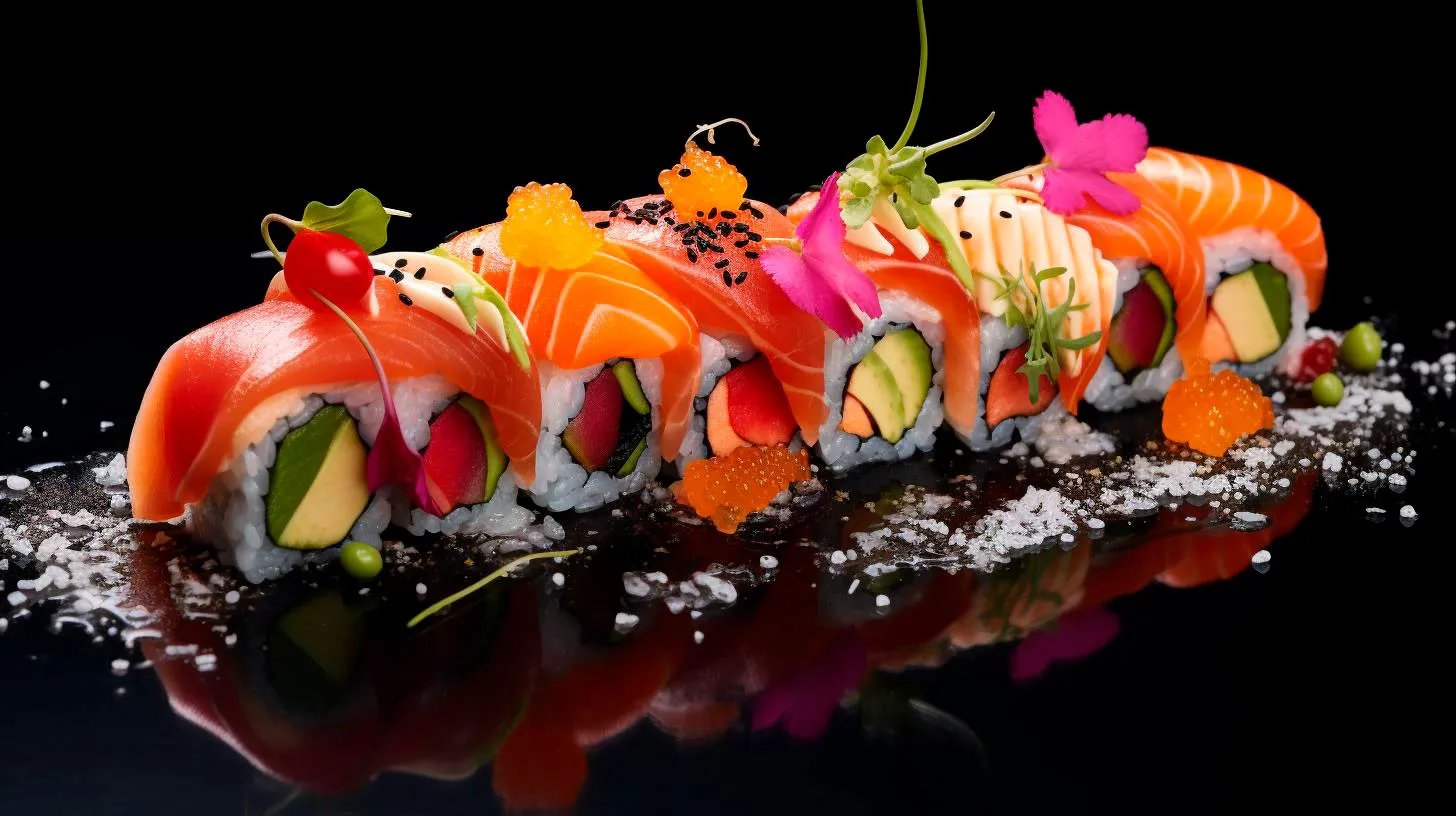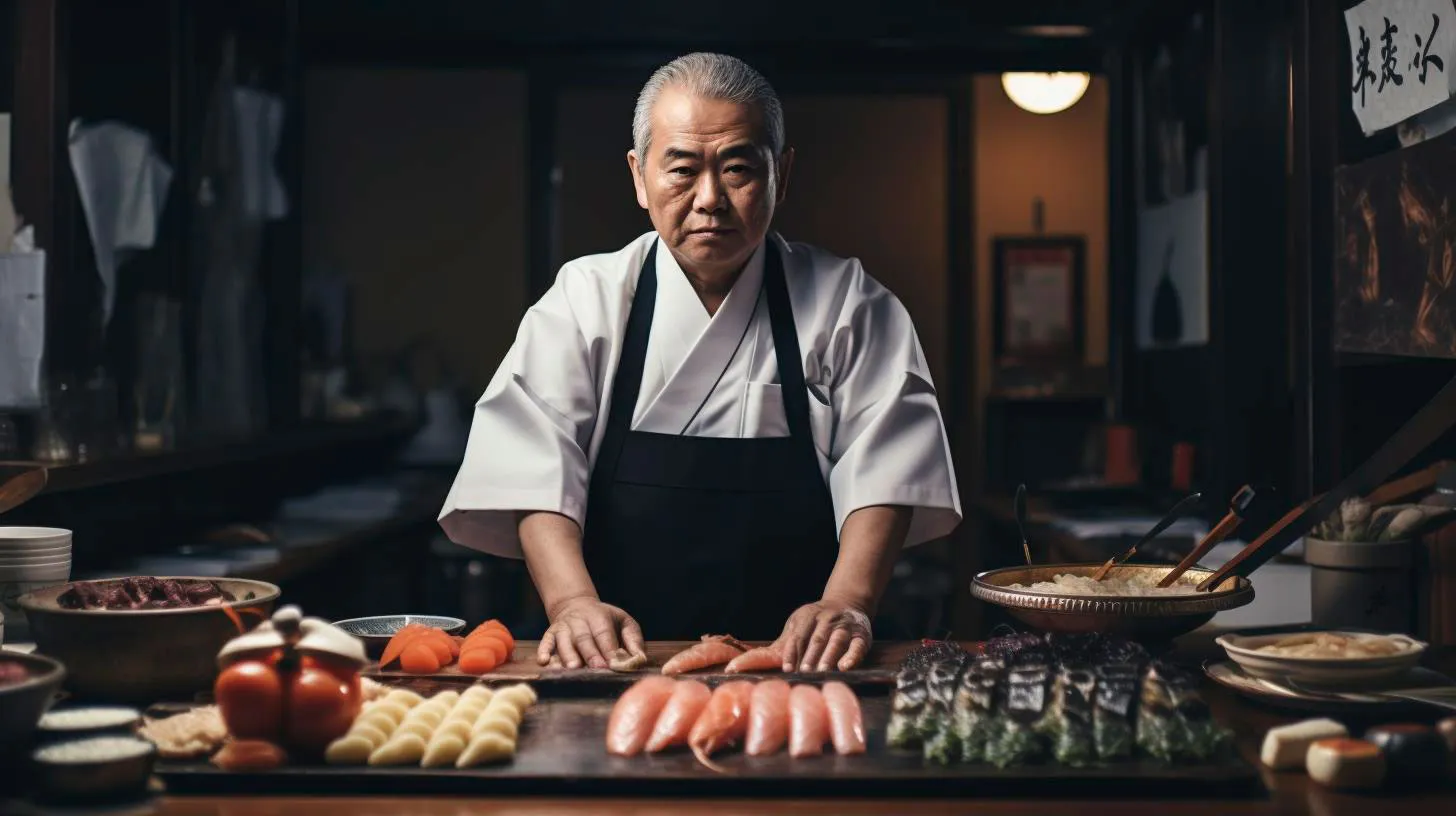The Cultural Significance of Sushi in Japanese Seasonal Celebrations
Sushi: A Culinary Masterpiece
Sushi is considered a culinary masterpiece that originated in Japan and has evolved over centuries. It is made by combining vinegared rice, known as shari, with a variety of ingredients such as fresh fish, seafood, vegetables, and sometimes exotic flavors. The art lies in the careful selection and preparation of these ingredients, as well as the meticulous presentation of each sushi roll or nigiri.
Throughout Japan, sushi holds a special place in people’s hearts, and it is not limited to fine dining establishments. Sushi can be found in all corners of the country, from high-end sushi bars to humble food stalls, making it accessible to people from all walks of life.
The Bond Between Sushi and Japanese Seasonal Celebrations
In Japan, each season is celebrated with unique festivals that showcase the beauty of nature and its changing landscapes. These celebrations often incorporate traditional rituals, vibrant decorations, and, of course, a special menu featuring seasonal ingredients, including sushi.
Cherry Blossom Season
One of the most anticipated seasonal events in Japan is the blooming of cherry blossoms, known as sakura. This celebration marks the arrival of spring and is accompanied by hanami, the custom of enjoying the aesthetic beauty of cherry blossoms. During this time, sushi rolls with delicate pink hues resembling cherry blossoms are created, signifying the ephemeral nature of life.
Summer Festivals
Summer in Japan is synonymous with lively festivals such as Obon and Tanabata. These festivities revolve around traditional dances, vibrant parades, and colorful fireworks. Sushi, often served in small boxes or bento, takes center stage as a convenient and delectable option for festival-goers to enjoy while celebrating.
Harvest Season
Autumn brings the annual rice harvest in Japan, and it is a time for expressing gratitude for the bountiful crops. Sushi made with seasonal ingredients such as mushrooms, sweet potatoes, and pears is savored during this time, highlighting the connection between the land, its people, and the food they produce.
New Year Celebrations
As the year comes to an end, Japan welcomes the New Year with traditional ceremonies and customs. Osechi Ryori, a special meal consisting of various dishes prepared in advance and consumed during the first few days of the year, is an integral part of these celebrations. Sushi, carefully crafted into beautiful shapes and colors, is an essential element of Osechi Ryori, symbolizing good luck and prosperity for the coming year.
The Significance of Sushi in Japanese Culture
Beyond its association with seasonal celebrations, sushi embodies essential aspects of Japanese culture. Here are some key takeaways:
- Precision and Perfection: The preparation of sushi requires meticulous attention to detail, reflecting the Japanese value of precision and perfection.
- Respect for Nature: Sushi often features fresh, seasonal ingredients, emphasizing the Japanese philosophy of respecting and celebrating nature’s cycles.
- Reflection of Aesthetics: Sushi’s artful presentation, harmonious colors, and delicate flavors are a manifestation of the Japanese aesthetic sense.
- Community and Sharing: Enjoying sushi is a social experience that brings people together, reinforcing the importance of community and shared meals in Japanese society.
Statistics show the popularity and influence sushi holds in Japanese culture:
- Japan has over 45,000 sushi restaurants, with more than 100,000 sushi chefs dedicated to preserving the culinary traditions.
- The global sushi market is estimated to reach a value of $22 billion by 2025, indicating its widespread popularity and consumption beyond Japan.
- During the annual Tsukiji Fish Market auction in Tokyo, the most expensive bluefin tuna ever sold reached a staggering price of $3.1 million, demonstrating the high demand for quality fish used in sushi.
Sushi continues to transcend borders and captivate the palates of people worldwide, showcasing the cultural richness of Japan and its traditions that endure over time.
As you delve into the world of sushi and its significance in Japanese seasonal celebrations, take a moment to appreciate the artistry, flavors, and cultural heritage that every sushi roll embodies. Whether it is enjoying sakura-themed sushi during cherry blossom season or relishing Osechi Ryori during New Year’s festivities, sushi provides a taste of Japan’s cultural vibrancy and the importance of honoring nature and traditions.
Unraveling the Connection between Sushi and Japanese Seasonal Rituals
In this article, we delve into the fascinating bond between sushi and the changing seasons in Japan.
The Essence of Sushi
Sushi is a traditional Japanese dish that originated during the Edo period and has evolved over centuries. It typically consists of vinegared rice, known as shari, combined with a variety of ingredients such as raw or cooked seafood, vegetables, and sometimes tropical fruits, all carefully wrapped with seaweed, known as nori.
Japanese sushi chefs are revered for their dedication to perfection, paying meticulous attention to every ingredient, arranging them aesthetically, and ensuring the flavors blend harmoniously. This culinary artistry has helped sushi gain global acclaim and become synonymous with Japanese cuisine.
The Four Seasons, a Reflective Tradition
Japanese culture places immense importance on the changing seasons and their impact on daily life. This reverence for nature is evident in various artistic forms, including traditional haiku poetry, cherry blossom festivals, and, of course, the preparation and consumption of food.
Sushi is no exception, as it embraces the concept of “shun.” Shun refers to the moment when ingredients are at their peak freshness and flavor. In Japanese gastronomy, appreciating this optimal seasonality is crucial, and sushi offers the ideal canvas for showcasing seasonal ingredients.
Seasonal Sushi and Delights
Throughout the year, sushi-preparation techniques, as well as the ingredients used, vary based on the seasons. Listed below are some examples of how sushi adapts to the ever-changing Japanese landscape:
Spring:
- Sakura-gai: This seasonal shellfish is loved for its vibrant pink color and delightful umami flavor, often found in delicate nigiri sushi.
- Engawa: During spring, sushi enthusiasts eagerly anticipate engawa, a tender and fatty fish fin muscle, often lightly seared and served on sushi.
- Tai: Also known as sea bream, tai is a symbol of good luck and prosperity. Its subtle sweetness is celebrated during springtime.
Summer:
- Hamaguri: These saltwater clams are best enjoyed during the warm summer months, providing a slightly sweet and briny taste in sushi rolls.
- Unagi: Grilled freshwater eel, unagi, often glazed with a sweet and savory sauce, is a popular sushi ingredient during summertime.
- Tomato: While tomatoes may seem unconventional, their refreshing taste and vibrant colors add a unique twist to sushi offerings.
Autumn:
- Sanma: This seasonal fish, known as Pacific saury, is often grilled and served in sushi rolls during the autumn months.
- Matsutake: Highly regarded in Japanese cuisine, matsutake mushrooms are cherished for their intense aroma and earthy flavor, making them an autumn sushi delicacy.
- Sweet Potato: In autumn, sweet potato tempura sushi rolls offer a delightful contrast of textures and flavors.
Winter:
- Fugu: Winter is the peak season for fugu, a highly prized pufferfish known for its potentially dangerous preparation process. Skilled sushi chefs carefully remove the poisonous parts, creating a delectable and thrilling dining experience.
- Ika: Winter marks the arrival of ika, or squid, which boasts a firm texture and slightly sweet taste when served as sushi.
- Gobo: The root vegetable known as burdock, or gobo, is a popular sushi filling in winter, offering a unique crunch and earthy flavor.
Key Takeaways
Sushi, a global culinary phenomenon, is much more than an expertly crafted dish—it exemplifies the connection between Japanese food culture and the changing seasons. By understanding the interplay between sushi and the time of year, one can fully appreciate the art, history, and traditions behind this iconic cuisine.
Key Takeaways:
- Sushi showcases the concept of “shun,” emphasizing the importance of utilizing seasonal ingredients at their peak freshness.
- Each season presents unique sushi delicacies, such as Sakura-gai in spring, Hamaguri in summer, Sanma in autumn, and Fugu in winter.
- The ability to adapt sushi to the seasons demonstrates the creativity and versatility of Japanese cuisine.
- Japanese culture’s deep appreciation for nature, reflected in various aspects of life, including the art of sushi preparation.
So, the next time you indulge in a plate of sushi, take a moment to savor not only the flavors but also the rich traditions and seasonal stories it holds. Understanding the connection between sushi and Japanese seasonal rituals enhances the dining experience, allowing you to truly savor the essence of this beloved cuisine.
Understanding the Symbolic Importance of Sushi in Japanese Seasonal Events
More than just a delicious dish, sushi holds deep symbolic significance in Japanese culture, particularly during seasonal events. In this article, we will delve into the cultural significance of sushi and how it is intertwined with Japanese seasonal traditions.
The Symbolism of Sushi
1. Tradition and Symbol of Celebration: Sushi is often associated with special occasions and celebrations in Japan. Its inclusion in seasonal events signifies the importance of tradition in Japanese culture and the value placed on cherished customs. The artful preparation of sushi reflects the meticulousness and dedication that permeates many Japanese festivities.
2. Seasonal Ingredients: Sushi showcases the freshest and most seasonal ingredients available. The use of locally sourced produce ensures that each sushi roll highlights the flavors and textures unique to a particular time of year. From delicate cherry blossom-inspired sushi in spring to luxurious sea urchin in winter, the changing seasons are painstakingly reflected in the composition of sushi.
3. Harmony and Balance: Just like Zen Buddhism, which greatly influenced Japanese culture, sushi emphasizes the importance of harmony and balance. Each piece of sushi is crafted with precision, seeking to achieve the perfect combination of flavors, textures, and colors. This pursuit of balance reflects the Japanese principle of “wa,” which promotes inner peace and a deep connection with nature.
Sushi in Japanese Seasonal Events
Japanese seasonal events or “kisetsukan” are an integral part of the country’s cultural tapestry. These events celebrate the changing of seasons and pay homage to nature’s rhythms. Let’s explore how sushi plays a role in some of the most prominent seasonal events:
1. Cherry Blossom Festival (Hanami)
– During Japan’s iconic cherry blossom season, sushi adorned with pink hues and delicate flavors are crafted to resemble the beauty of cherry blossoms.
– Sushi rolls may include ingredients like pickled plum (umeboshi), sakura-flavored rice, and pink-tinted shrimp to evoke the essence of cherry blossoms in each bite.
– The visual representation of cherry blossoms in sushi symbolizes the transient nature of life, as the blooms only last for a short period each year.
2. New Year (Oshogatsu)
– New Year is a significant event in Japan, marked by various customs and traditions. One such tradition is the consumption of “osechi ryori,” a special meal eaten during the first few days of the year.
– Sushi known as “osechi sushi” forms an essential part of this celebratory feast. Each sushi roll represents a different wish for the upcoming year, such as good health, happiness, or prosperity.
– Osechi sushi is meticulously prepared with ingredients that symbolize different aspects of life, creating a visually stunning and meaningful display on the New Year’s table.
3. Harvest Festival (Niinamesai)
– In autumn, Japan celebrates the bountiful harvest with the Niinamesai festival, also known as the “Festival of the First Fruits.”
– Sushi made from seasonal ingredients like mushrooms, sweet potatoes, and various root vegetables takes center stage during this event.
– The abundance of ingredients in the sushi reflects gratitude for a successful harvest and serves as a reminder of the interconnectedness between humans and nature.
Key Takeaways
The symbolic importance of sushi in Japanese seasonal events is a testament to the deep respect for tradition, nature, and balance within Japanese culture. A few key takeaways to remember about sushi’s significance in these events include:
- Sushi carries symbolism of celebration, tradition, and attention to detail.
- The use of seasonal ingredients showcases the changing flavors of each season.
- Sushi embodies the Japanese principles of harmony, balance, and inner peace.
- In cherry blossom festivals, sushi visually represents the fleeting beauty of life.
- Osechi sushi carries wishes for the upcoming year during New Year celebrations.
- In harvest festivals, sushi showcases gratitude for nature’s abundance and interconnectedness.
Next time you savor a piece of sushi, take a moment to appreciate the rich symbolism it embodies. From its meticulous preparation to its visual representation of Japan’s seasonal events, sushi serves as both a culinary delight and a window into the cultural tapestry of Japan.
Exploring the Role of Sushi in Traditional Japanese Festivities
In this article, we will delve into the role of sushi in traditional Japanese festivities, its cultural significance, and how it has evolved over time.
The Origins of Sushi
Sushi originated in Southeast Asia as a means for preserving fish using fermentation. However, it was the Japanese who transformed this preservation method into the delicacy we know today. In ancient times, sushi was primarily consumed during religious festivals and as an offering to the gods. Over time, it became an integral part of Japanese culture.
Key Takeaway:
- Sushi has its roots in Southeast Asia but was perfected in Japan.
- Originally consumed during religious festivals, it later became a staple in Japanese cuisine.
Cultural Significance of Sushi
In Japanese culture, food goes beyond just nourishment; it carries immense cultural value. Sushi represents a deep connection with nature and the changing seasons. Traditional festivals in Japan are often centered around agricultural events, like rice planting and harvest. Sushi, made with fresh, seasonal ingredients, reflects this connection with nature and the importance of harmonizing with the environment.
Moreover, sushi is commonly associated with celebrations and joyous occasions. It is often served at weddings, birthdays, and other festive events. Sharing sushi with loved ones has become a symbol of unity, gratitude, and togetherness.
Key Takeaway:
- Sushi symbolizes harmony with nature and the changing seasons.
- It is considered a dish of joy and is commonly shared during celebrations.
Sushi in Festivals
When exploring the role of sushi in traditional Japanese festivities, it is impossible to overlook the influence it has had on specific celebrations. Here are some festivals where sushi plays a significant role:
1. Setsubun
Setsubun, also known as the Bean-Throwing Festival, is celebrated to mark the arrival of spring. On this day, sushi rolls known as “Eho-maki” are eaten while facing the lucky direction of the year. It is believed that consuming Eho-maki in one sitting without speaking brings good luck for the year ahead.
2. Hinamatsuri
Hinamatsuri, or Girls’ Day, is dedicated to celebrating the happiness and well-being of young girls. As part of the festivities, chirashizushi, a colorful sushi dish with scattered toppings, is often enjoyed. It showcases the culinary artistry and creativity of Japanese cuisine.
3. Oshogatsu
Oshogatsu, the Japanese New Year, holds great importance in Japanese culture. On this occasion, families come together to celebrate and enjoy a special meal known as “Osechi.” This traditional New Year’s feast consists of various dishes, including sushi, symbolizing good luck and prosperity.
Key Takeaway:
- Sushi plays a significant role in various Japanese festivals like Setsubun, Hinamatsuri, and Oshogatsu.
- Specific sushi dishes are prepared and consumed during these festivities.
The Evolution of Sushi
While sushi has deep roots in tradition, it has also evolved to cater to a modern and global audience. Over the years, various sushi styles and fillings have emerged, showcasing the versatility of this beloved dish.
One notable adaptation is “California Roll,” created in the 1960s in Los Angeles to accommodate the Western palate. It contains avocado, cucumber, and crabmeat, making it more accessible to those unfamiliar with raw fish. This fusion of flavors and textures revolutionized sushi consumption worldwide.
Key Takeaway:
- Sushi has evolved to include various styles and fillings, appealing to a global audience.
- Introduction of fusion sushi, like the California Roll, made it more approachable to Western tastes.
In conclusion, sushi not only tantalizes taste buds but also carries a significant role in traditional Japanese festivities. From its origins as a preservation method to becoming a cultural icon, sushi represents the values and traditions deeply rooted in Japanese culture. Whether consumed during religious ceremonies, shared with loved ones during celebrations, or adapted to cater to international palates, sushi continues to be a truly cherished and versatile delicacy.



